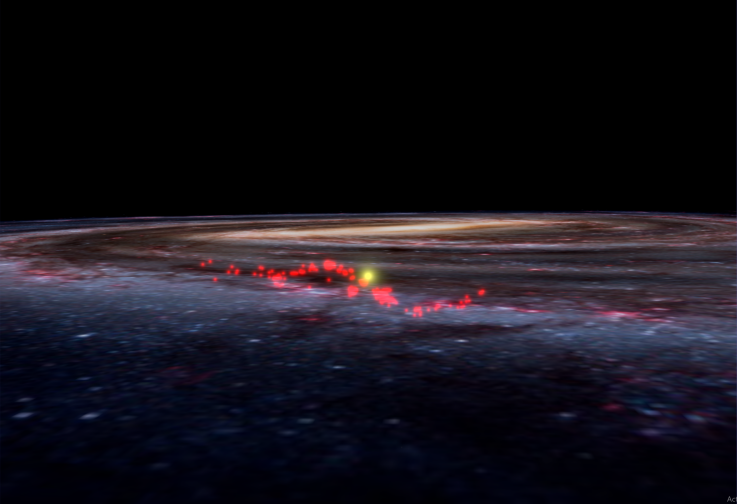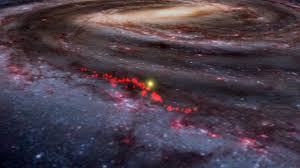An enormous wave has been discovered in the Milky Way that may have formed as a result of a collision with a massive mystery object—potentially a clump of dark matter—scientists have said.
Source: Newsweek
The “Radcliffe wave” was discovered using data from the European Space Agency’s Gaia satellite. It had previously gone unnoticed because of its extreme size and our proximity to it. From Earth, the wave covers half the sky, making it difficult to see the whole structure. Details of the discovery are published in Nature.
Our galaxy is known as a spiral galaxy. It is largely a flat, rotating disk with arms that circle it. It is about 100,000 light years across, but only around 1,000 light years thick.
Researchers led by João Alves, from the Department of Astrophysics at the University of Vienna and the Radcliffe Institute for Advanced Study at Harvard University, were initially trying to map a structure known as the Gould’s Belt. This is a large band of star-forming regions that the team was hoping to learn more about with Gaia—a mission to create a 3D map of the Milky Way.
In doing so, the team discovered that Gould’s belt is “just a projection effect” of a far larger structure, Alves told Newsweek. “As you can imagine, I was very surprised,” he said. The Radcliffe wave, they found, was one enormous, long filament. It stretches 9,000 light years in length and 400 in width. It was also found to go 500 light years above and below the mid plane of the galactic disk in a wave-like shape.
The wave, which is made up of interconnected stellar nurseries, is very close to the Milky Way. At its closest point, the Sun is just 500 light years from the wave. “The reason why we didn’t realize the presence of this giant is that we didn’t have the exquisite distance measurements we have today with Gaia and, I think because we are so close to the structure it’s hard to see it.”

What could have produced the wave is not known. However, its amplitude appears to be decreasing over time. For it to be a damped wave it immediately suggests some sort of trigger, perhaps a collision between the disk of our Milky Way and a massive object—that we so far could not identify. It could have been a clump of dark matter, which would explain why we cannot find an obvious candidate for the collision.
“But this is very speculative at the moment, and other scenarios are as plausible, as an accretion of gas either from the halo of the Milky Way, stretched by the tidal forces of the Galaxy (hence it’s narrowness). Or maybe this is what spiral arms look like up close. In summary, we have many ideas that we will be testing with future releases of Gaia data but we don’t have a favorite scenario at the moment, and that is pretty exciting.”
The team also found the wave interacts with the Sun. It crossed our path about 13 million years ago and will again in another 13 million years. What happened during this encounter is also unknown.
“There was no obvious mass extinction event 13 million years ago, so although we were crossing a sort of minefield back then, it did not leave an obvious mark,” Alves said. “Still, with the advent of more sensitive mass spectrometers, it is likely we will find some sort of mark left on the planet.”
He also said the wave and the new stars it produces are our new galactic neighbours, as our solar system is traveling along the same direction at about the same speed. And we are stuck with these new neighbors for the longest time—our Sun will die before most of these new neighbor stars. They will be our new travel companions around the Milky Way.”
The team now hopes to find other similar structures in other parts of the Milky Way. They are also trying to locate and measure the wave’s teenage stars, as these inherit the motions of the parental cloud, therefore important properties of it. This should help them work out what could have caused the wave to form. “We will find the reason for the undulation, I am confident,” Alves said.
Source: Newsweek

































Leave a Comment
You must be logged in to post a comment.